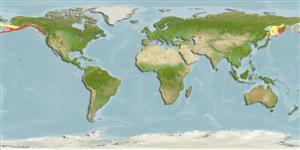Environment: milieu / climate zone / depth range / distribution range
Ecología
marino demersal; rango de profundidad 0 - 1100 m (Ref. 50550). Temperate; 66°N - 46°N
North Pacific: Sea of Okhotsk and the Sea of Japan (Ref. 559) to the Bering Sea and southern Puget Sound, Washington, USA.
Tamaño / Peso / Age
Maturity: Lm ? range ? - ? cm
Max length : 7.0 cm TL macho / no sexado; (Ref. 56527)
Short description
Claves de identificación | Morfología | Morfometría
Espinas dorsales (total) : 10 - 12; Radios blandos dorsales (total) : 12 - 17; Espinas anales: 0; Radios blandos anales: 12 - 14. Caudal fin rounded.
Found on soft bottoms and possibly rocky bottoms (Ref. 2850). Reported near shore (Ref. 2850). Prefers low temperatures (Ref. 6885).
Life cycle and mating behavior
Maturities | Reproducción | Spawnings | Egg(s) | Fecundities | Larva
Eschmeyer, W.N., E.S. Herald and H. Hammann, 1983. A field guide to Pacific coast fishes of North America. Boston (MA, USA): Houghton Mifflin Company. xii+336 p. (Ref. 2850)
IUCN Red List Status (Ref. 130435)
Threat to humans
Harmless
Human uses
Herramientas
Special reports
Download XML
Fuentes de Internet
Estimates based on models
Preferred temperature (Ref.
123201): 1.5 - 6.8, mean 5.2 °C (based on 144 cells).
Phylogenetic diversity index (Ref.
82804): PD
50 = 0.5005 [Uniqueness, from 0.5 = low to 2.0 = high].
Bayesian length-weight: a=0.00389 (0.00180 - 0.00842), b=3.12 (2.94 - 3.30), in cm total length, based on all LWR estimates for this body shape (Ref.
93245).
Nivel trófico (Ref.
69278): 3.2 ±0.4 se; based on size and trophs of closest relatives
Fishing Vulnerability (Ref.
59153): Low vulnerability (10 of 100).
